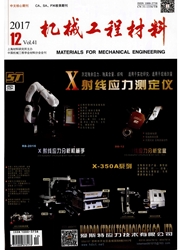

 中文摘要:
中文摘要:
针对汽车用6061和6063铝合金薄壁结构,先进行了准静态拉伸试验和180°弯曲试验,得到了铝合金的真应力-真应变曲线;然后采用线性回归拟合的方法建立了铝合金韧性断裂的本构模型,在此基础上,建立了铝合金薄壁结构压缩失效的有限元模型,并通过轴向压缩试验验证了有限元模型的准确性。结果表明:拉伸后,6061铝合金的表面呈橘皮形貌,6063铝合金的表面比较光滑;两种铝合金的断裂均为韧性断裂,6063铝合金具有更好的韧性;6061和6063铝合金的韧性断裂准则参数分别为104.81 MPa和179.91 MPa;有限元预测得到的铝合金薄壁结构的失效行为与试验结果比较吻合,证明了铝合金韧性断裂本构模型的正确性。
 英文摘要:
英文摘要:
According to the thin-walled structure of 6061 and 6063 aluminum alloys, the true stress-strain curve were obtained by quasi-static tensile test and 180 degree bending experiment, and then, the constitutive model for ductile fracture was established by linear regression fitting. On this basis, compression failure finite element model for aluminum alloy thin-walled structure was built, and the accuracy of the finite element model was verified by axial compression test. The results show that the surface of 6061 aluminum alloy was peel morphology, while the surface of 6063 aluminum alloy was smooth; the fracture modes of two kinds of aluminum alloys were ductile fracture; the toughness of 6063 aluminum alloy was better than that of 6061 aluminum alloy; the parameters of fracture model of 6061 and 6063 aluminum alloys were 104. 81 MPa and 179.91 MPa; the failure behavior of aluminum alloy thin-walled structure obtained by simulation and experiment were in good agreement, which indicated that the ductile fracture constitutive model of aluminum alloys was accurate.
 同期刊论文项目
同期刊论文项目
 同项目期刊论文
同项目期刊论文
 期刊信息
期刊信息
